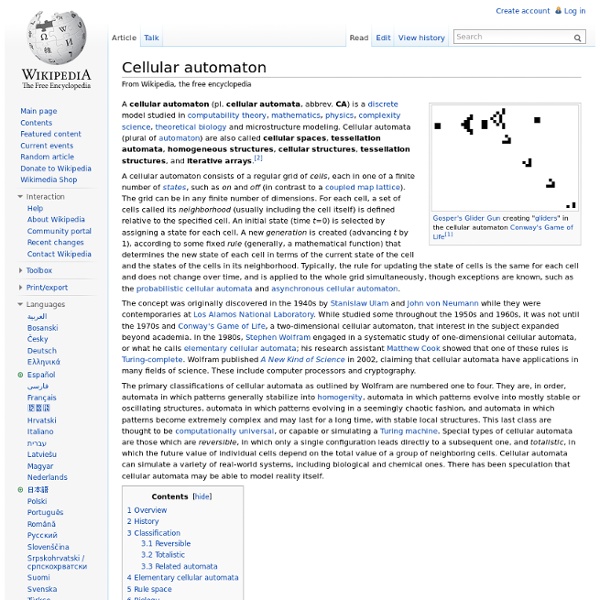Agent-based model
An agent-based model (ABM) is one of a class of computational models for simulating the actions and interactions of autonomous agents (both individual or collective entities such as organizations or groups) with a view to assessing their effects on the system as a whole. It combines elements of game theory, complex systems, emergence, computational sociology, multi-agent systems, and evolutionary programming. Monte Carlo Methods are used to introduce randomness. Particularly within ecology, ABMs are also called individual-based models (IBMs),[1] and individuals within IBMs may be simpler than fully autonomous agents within ABMs. Agent-based models are a kind of microscale model [3] that simulate the simultaneous operations and interactions of multiple agents in an attempt to re-create and predict the appearance of complex phenomena. History[edit] The idea of agent-based modeling was developed as a relatively simple concept in the late 1940s. Early developments[edit] 2000s and later[edit]
University of Michigan, Center for the Study of Complex Systems
Fractal
Figure 1a. The Mandelbrot set illustrates self-similarity. As the image is enlarged, the same pattern re-appears so that it is virtually impossible to determine the scale being examined. Figure 1b. Figure 1c. Figure 1d. Fractals are distinguished from regular geometric figures by their fractal dimensional scaling. As mathematical equations, fractals are usually nowhere differentiable.[2][5][8] An infinite fractal curve can be conceived of as winding through space differently from an ordinary line, still being a 1-dimensional line yet having a fractal dimension indicating it also resembles a surface.[7]:48[2]:15 There is some disagreement amongst authorities about how the concept of a fractal should be formally defined. Introduction[edit] The word "fractal" often has different connotations for laypeople than mathematicians, where the layperson is more likely to be familiar with fractal art than a mathematical conception. History[edit] Figure 2. Figure 3. uniform mass center triangle fractal
Institute for Complex System Simulations (Home page)
Percolation threshold
Percolation threshold is a mathematical term related to percolation theory , which is the formation of long-range connectivity in random systems. Below the threshold a giant connected component does not exist; while above it, there exists a giant component of the order of system size. In engineering and coffee making , percolation represents the flow of fluids through porous media, but in the mathematics and physics worlds it generally refers to simplified lattice models of random systems or networks (graphs), and the nature of the connectivity in them. The percolation threshold is the critical value of the occupation probability p , or more generally a critical surface for a group of parameters p 1 , p 2 , ..., such that infinite connectivity ( percolation ) first occurs. [ edit ] Percolation models In the systems described so far, it has been assumed that the occupation of a site or bond is completely random—this is the so-called Bernoulli percolation. [ edit ] 2-Uniform Lattices or . .
039;s Center for Social Dynamics and Complexity
November 5-6, 2010 2010 Computational Social Science Society Conference September 30 - October 2, 2010 IASC North American Regional Meeting CSDC joins the Consortium for Biosocial Complex Systems Together with the Center for Institutional Diversity and the Mathematical, Computational, and Modeling Sciences Center, the CSDC has been brought into the Consortium for Biosocial Complex Systems under the leadership of Sander van der Leeuw. "Integration is the key to being a leader in solving complex challenges," van der Leeuw says. The new Consortium is also a part of the university-wide Complex Adaptive Systems Initiative headed by Sander van der Leeuw and George Poste.
Complex systems
Complex systems present problems both in mathematical modelling and philosophical foundations. The study of complex systems represents a new approach to science that investigates how relationships between parts give rise to the collective behaviors of a system and how the system interacts and forms relationships with its environment.[1] Such systems are used to model processes in computer science, biology,[2] economics, physics, chemistry,[3] and many other fields. It is also called complex systems theory, complexity science, study of complex systems, sciences of complexity, non-equilibrium physics, and historical physics. A variety of abstract theoretical complex systems is studied as a field of mathematics. The key problems of complex systems are difficulties with their formal modelling and simulation. Overview[edit] History[edit] A history of complexity science Typical areas of study[edit] Complexity management[edit] Complexity economics[edit] Complexity and modeling[edit] 1. Americas Europe
Complex adaptive system
They are complex in that they are dynamic networks of interactions, and their relationships are not aggregations of the individual static entities. They are adaptive in that the individual and collective behavior mutate and self-organize corresponding to the change-initiating micro-event or collection of events.[1][2] Overview[edit] The term complex adaptive systems, or complexity science, is often used to describe the loosely organized academic field that has grown up around the study of such systems. Complexity science is not a single theory— it encompasses more than one theoretical framework and is highly interdisciplinary, seeking the answers to some fundamental questions about living, adaptable, changeable systems. The fields of CAS and artificial life are closely related. The study of CAS focuses on complex, emergent and macroscopic properties of the system.[3][11][12] John H. General properties[edit] Characteristics[edit] Robert Axelrod & Michael D. Modeling and Simulation[edit]



